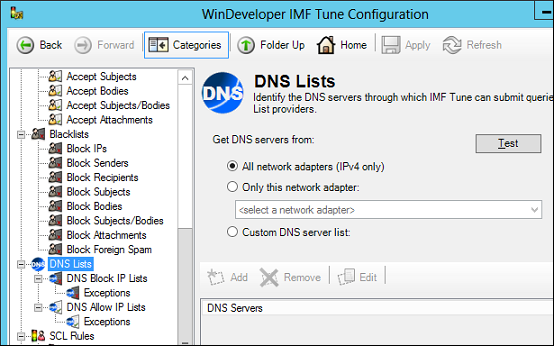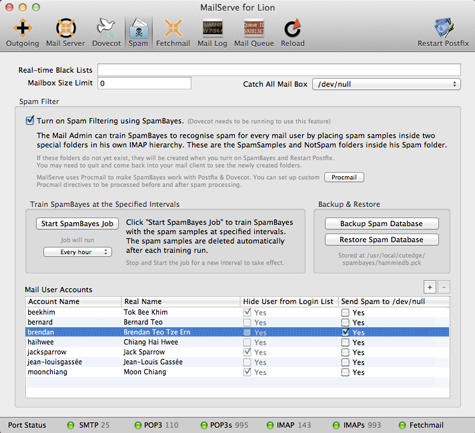

URI DNSBLs were created when it was determined that much spam made it past spam filters during that short time frame between the first use of a spam-sending IP address and the point where that sending IP address was first listed on major sending-IP-based DNSBLs. URI DNSBLs Ī Uniform Resource Identifier (URI) DNSBL is a DNSBL that lists the domain names and sometimes also IP addresses which are found in the "clickable" links contained in the body of spams, but generally not found inside legitimate messages. Technical specifications for DNSBLs came relatively late in RFC5782. In August 2003, the firm Osirusoft, an operator of several DNSBLs including one based on the SPEWS data set, shut down its lists after suffering weeks of near-continuous attack. However, many observers believe the attacks are perpetrated by spammers in order to interfere with the DNSBLs' operation or hound them into shutting down.

Since no party has admitted to these attacks nor been discovered responsible, their purpose is a matter of speculation.

In 2003, a number of DNSBLs came under denial-of-service attacks (DOS).

ORBS was controversial at the time because many people felt running an open relay was acceptable, and that scanning the Internet for open mail servers could be abusive. This used automated testing to discover and list mail servers running as open mail relays-exploitable by spammers to carry their spam. One of the first was Alan Brown's Open Relay Behavior-modification System (ORBS). Soon after the advent of the RBL, others started developing their own lists with different policies.
#Turn on spam protection based on dns blackhole lists software#
These allowed the mail software to query the RBL and reject mail from listed sites on a per-mail-server basis instead of black-holing all traffic. Later, the RBL was also released in a DNSBL form and Paul Vixie encouraged the authors of sendmail and other mail software to implement RBL support in their clients. Such effort was considered very important before black-holing all network traffic, but it also meant that spammers and spam supporting ISPs could delay being put on the RBL for long periods while such discussions went on. Before an address would be listed on the RBL, volunteers and MAPS staff would attempt repeatedly to contact the persons responsible for it and get its problems corrected. The intent of the RBL was that sites using it would refuse traffic from sites which supported spam - whether by actively sending spam, or in other ways. The term "blackhole" refers to a networking black hole, an expression for a link on a network that drops incoming traffic instead of forwarding it normally. The inventor of the technique later commonly called a DNSBL was Eric Ziegast while employed at Vixie Enterprises. The very first version of the RBL was not published as a DNSBL, but rather a list of networks transmitted via BGP to routers owned by subscribers so that network operators could drop all TCP/IP traffic for machines used to send spam or host spam supporting services, such as a website. The first DNSBL was the Real-time Blackhole List (RBL), created in 1997, at first as a Border Gateway Protocol (BGP) feed by Paul Vixie, and then as a DNSBL by Eric Ziegast as part of Vixie's Mail Abuse Prevention System (MAPS) Dave Rand at Abovenet was its first subscriber. In addition, a small number of DNSBL operators have been the target of lawsuits filed by spammers seeking to have the lists shut down. Many email systems operators and users consider DNSBLs a valuable tool to share information about sources of spam, but others including some prominent Internet activists have objected to them as a form of censorship. Since the creation of the first DNSBL in 1998, the operation and policies of these lists have frequently been controversial, both in Internet advocacy circles and occasionally in lawsuits. These may include listing the addresses of zombie computers or other machines being used to send spam, Internet service providers (ISPs) who willingly host spammers, or those which have sent spam to a honeypot system. They use a wide array of criteria for listing and delisting addresses. Most mail server software can be configured to check such lists, typically rejecting or flagging messages from such sites.Ī DNSBL is a software mechanism, rather than a specific list or policy. ( September 2019)Ī Domain Name System blocklist, Domain Name System-based blackhole list, Domain Name System blacklist ( DNSBL) or real-time blackhole list ( RBL) is a service for operation of mail servers to perform a check via a Domain Name System (DNS) query whether a sending host's IP address is blacklisted for email spam. This article may need to be rewritten to comply with Wikipedia's quality standards.


 0 kommentar(er)
0 kommentar(er)
